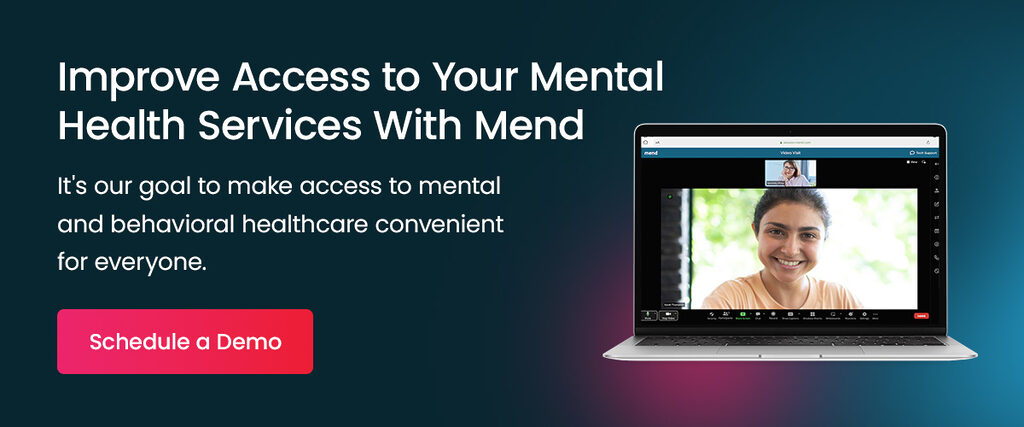
It’s no secret that technology plays a pivotal role in improving access to quality mental healthcare. Today, people can use their smartphones and tablets to find help and learn more about their symptoms. Telehealth solutions take things a step further and allow practices to deliver quality care to clients remotely over the internet. In many cases, telehealth platforms empower clinicians to provide affordable, face-to-face treatment regardless of a client’s geographical location or economic status.
As a behavioral or mental health provider, you’re always looking for ways to provide a better experience for your clients. With telehealth and patient engagement solutions, you can focus on providing the best care possible while giving clients the convenience they deserve. By embracing evolving treatment options, providers like you can continuously support improved client outcomes.
Understanding and Overcoming Barriers to Mental Health Treatment
The first step to overcoming roadblocks to mental health services is to understand the common challenges people face when seeking help. The top barriers to mental health treatment access include the following.
1. Social Stigma
Research suggests that many people hold stigmatizing views of people with mental illness and will even limit their interactions with them. Many people’s beliefs — and the beliefs of society — can prevent them from acknowledging and seeking help for their mental illness. Individuals interested in seeking help may feel embarrassed or ashamed about needing support, often for fear that they will face consequences for having a mental health condition.
Social stigma is a significant barrier to mental health treatment and often includes culturally determined stereotypes, prejudice and discrimination against those with a mental illness. Stigmatizing responses from family, friends and colleagues can deter people from seeking both informal and formal sources of treatment. Social stigma can lead to many negative outcomes, such as:
- Worsening symptoms.
- Psychological distress.
- Treatment delay.
- Negative views toward seeking treatment for mental health issues.
- Premature treatment dropout.
- Reduced help-seeking behaviors.
2. Education and Awareness

The general lack of mental health education and awareness can directly and indirectly discourage individuals from seeking help. Those who have a greater need for mental health treatment often do not understand or have the education to identify signs of mental illness. Some people may even assume that their mental or emotional state is normal, even if they experience clinical symptoms or disordered thinking. Essentially, if a person doesn’t know something is wrong, they’re not likely to seek mental health treatment.
Stigma and discrimination also contribute to how society views and responds to mental illness. Those who cannot recognize mental health illness symptoms may also not understand what treatment options are available and how they can help. A low or lack of perceived need for mental health treatment is also an important factor hindering help-seeking behaviors for unmet mental health challenges.
3. Geography and Transportation Limitations
Transportation to and from mental health facilities is a logistical barrier for many individuals, especially those in rural areas. Research shows that two-thirds of mental health professional shortage areas are located in rural areas. Additionally, longer distances to mental health services can hinder recovery, while public transportation options in these areas are extremely limited.
These burdens are worsened by the disparity of insurance access between rural and urban areas. When individuals cannot physically get to their mental health treatment facility, they’re less likely to get to their appointments on time and receive timely care.
4. Financial Resources
The cost of mental and behavioral health treatment can limit access to services, even with insurance or financial assistance. Though mental and behavioral health services are considered essential healthcare under the Affordable Care Act, many people find such assistance is not enough to cover out-of-pocket expenses, copays and specialty care costs.
A lack of financial resources can prevent individuals from seeking help, especially for severe diagnoses that require intensive treatment programs and medication management. A mental health study found that 42% of adults cite high costs as the top reason for unmet treatment needs. Among individuals with health insurance, 17% of respondents said it didn’t cover enough of the treatment costs.
5. Provider Shortage
A lack of available providers makes it challenging for people to find treatment in their areas. According to a 2023 study, about 169 million people in the U.S., over half the population, live in a mental health professional shortage area (HPSA). Additionally, significant shortages in the behavioral health workforce are projected in the future, highlighting the unmet need for psychiatrists, social workers, therapists, psychologists and addiction counselors.
The role of healthcare providers is critical — a shortage of clinicians means fewer options for people of lower income. Those who require specialty treatment or intensive therapy may not have access to clinicians in their area, even if they can afford to pay out-of-pocket costs.
Empowering Mental Health Providers With Technology
With the assistance of technology, providers can enhance mental healthcare access to help reduce the common barriers to mental health services. Evolving mental health treatment options, like telehealth software, enable providers to reach more clients in a streamlined, convenient manner. By diverging from traditional therapy models and exploring new interventions, providers can enhance their ability to meet the high demand for such services.
According to the American Psychological Association, digital therapy solutions will continue to play an essential role in providing mental health support, particularly to underserved communities. Leveraging telehealth software and similar technology can make it easier for practices to implement client-centered care models that prioritize a better experience. Digital therapy solutions can:
- Increase the availability of mental health professionals.
- Lower the time commitment from clients.
- Streamline provider workflows.
- Allow providers to remotely prescribe medication and manage therapy.
- Provide effective communication channels.
- Improve client engagement.
- Automate client payments.
- Digitize intake forms.
- Provide client appointment reminders.
- Offer clients self-scheduling tools.
- Help providers comply with privacy laws.
- Provide seamless EHR/PMS integration.
The importance of offering clients a seamless, hassle-free experience when seeking mental healthcare cannot be overstated. Streamlining the treatment process and eliminating common frustrations, such as poor communication, can also reduce the likelihood of no-shows and improve care delivery.
Improve Access to Your Mental Health Services With Mend
Everyone deserves access to quality behavioral and mental healthcare. Embracing new mental health treatment options like telehealth can reduce common barriers, such as location and transportation. Telehealth solutions can also address the stigma of asking for help by providing clients with an easy, accessible and convenient method of receiving care. Mend is a telehealth patient engagement platform that empowers providers with user-friendly features that automate workflows, improve client outcomes and increase client intake.
The intuitive Mend platform integrates with your electronic health record (EHR) for seamless scheduling and communication. At Mend, it’s our goal to make access to mental and behavioral healthcare convenient for everyone. Whether you’re looking to improve no-show rates or automate client payments, adopting new technology can help you achieve your goals. Schedule a demo today to see how Mend can help you keep up with the demands of the mental health field.
